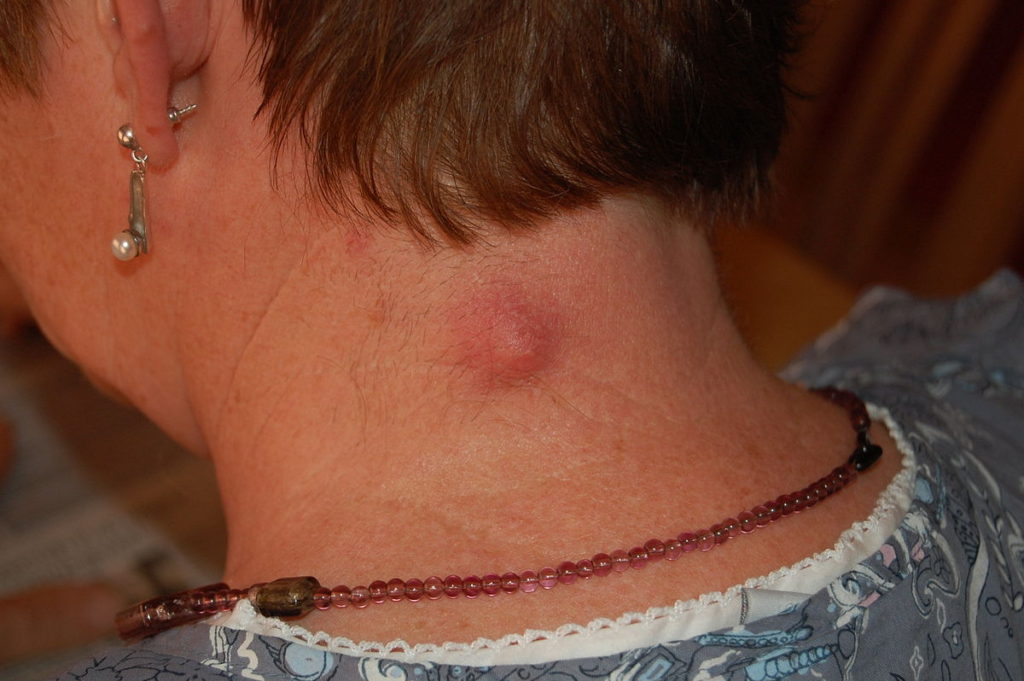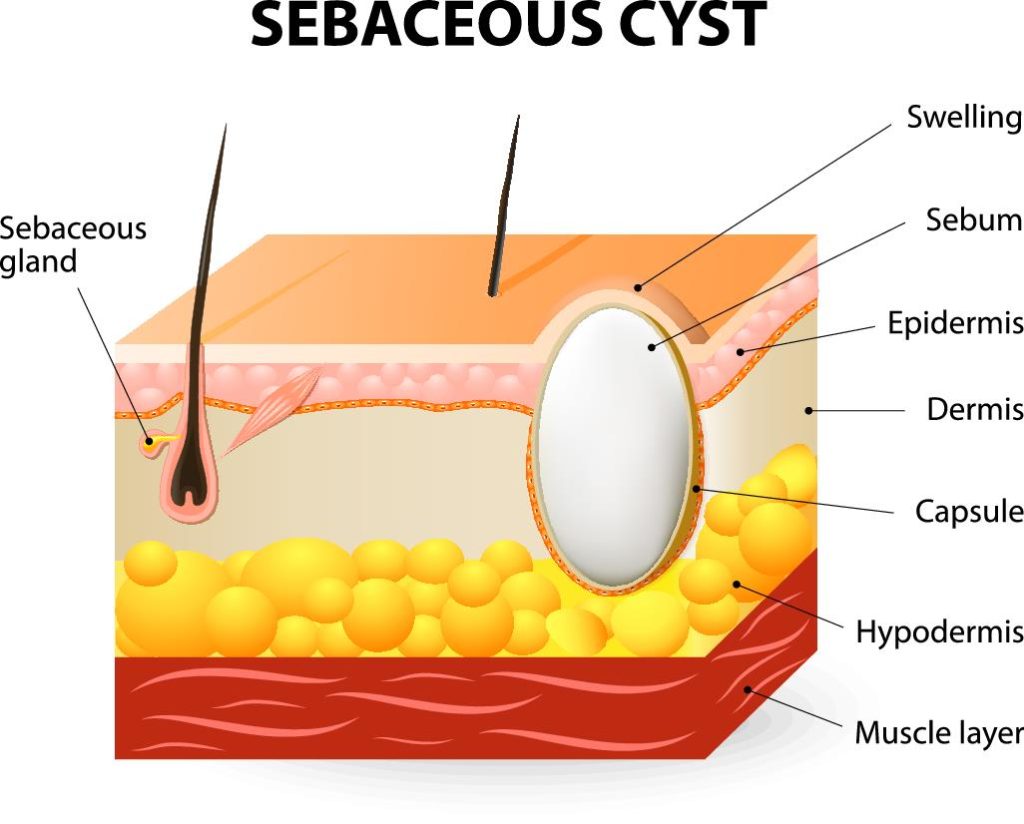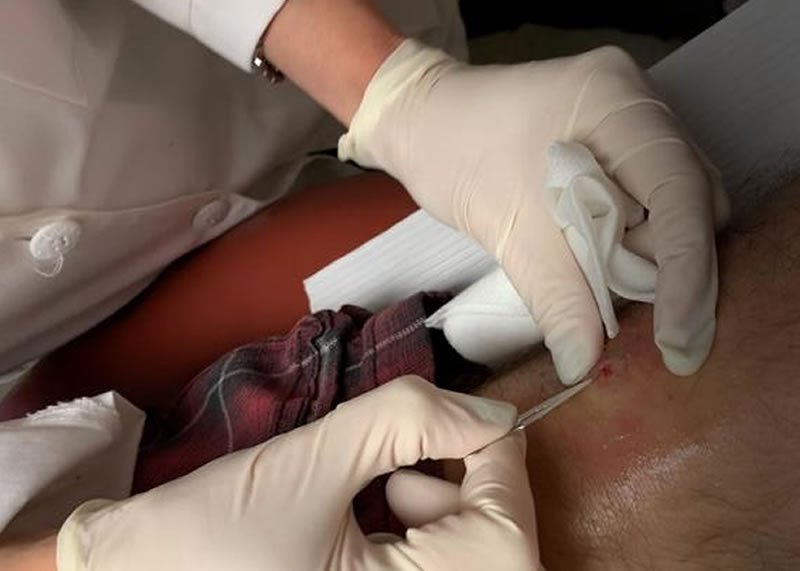Sebaceous Cysts
What is a Cyst?
A cyst is a benign, encapsulated lesion that consists of a fluid sac which contains liquid, or semi-fluid material. It can vary in shape, size and location. The most common types of cysts are reviewed here.
Acne, acne cysts, and sebaceous cysts are benign skin lesions and are one of the most common reasons which patients consult with dermatologists like Dr. Michele Green in Manhattan. Sebaceous cysts are the most common type of cyst, and are slow-growing noncancerous bumps on the skin. However, if sebaceous cysts are left untreated, they tend to enlarge, get infected, and cause cosmetic scarring. Dr. Michele Green treats these sebaceous cysts in her Upper East Side NYC office each day. Through her minimally invasive techniques, she treats these cysts in a cosmetically elegant way, and avoids any unnecessary scarring.
What is a Sebaceous Cyst?
A Sebaceous cyst is like a large pimple. Similar to acne, sebaceous cysts form within or near hair follicles. Sebaceous cysts are benign, firm or palpable growths, which can present as a small lump under the dermis. These cysts are formed from dirt, or excess oil, or a build-up of dead skin and sebum which gets trapped due to clogged hair follicles. Sebaceous cysts can grow rapidly, enlarging over the course of days or weeks.
These cysts most commonly present on the face, back and chest, where the majority of sebaceous glands exist. They do not occur on the palms of the hand or soles of the feet. Sebaceous cysts form a lump under the skin and initially looks like a small bump. The overlying skin is usually flesh colored or yellow in appearance due to the build up of sebum, pus, and keratin. These cysts grow slowly and can also be formed from trauma. Sebaceous cysts may initially be painless, although as large cysts develop, they often become painful. Most sebaceous cyst are not life-threatening, and they can often resolve on their own. However, some sebaceous cysts do not resolve and need further treatment. Depending on the location of the cyst, the amount of discomfort, the possibility of infection and scarring, and the cosmetic ramifications, these cysts will need to be treated and removed by Dr. Green in her NYC office.

Epidermoid Cysts
Epidermoid cysts are also referred to as epidermal cysts and are one of the most common forms of cutaneous cysts. Epidermoid cysts are due to the proliferation of epidermal cells within the dermis and generally form with or near the hair follicle.They are small lumps which develop under the skin. These cysts contain dead skin cells which look like small bumps, and the overlying skin is usually flesh colored, or yellow in appearance. Epidermoid cysts are primarily located on the face, neck, back, or genitals. They generally form in areas where there is little hair. Epidermoid cyst are often caused by clogged hair follicles due to a buildup of keratin. The epidermal cells form the walls of the cyst, and then secrete keratin into the interior of the cyst. Keratin is a protein found in the skin responsible for skin cell regeneration. These cysts can also be formed due to trauma and are called epidermal inclusion cysts. If these epidermal cysts become irritated, inflamed, or infected, they can be extremely painful.
Men are more than twice as likely as women to develop epidermoid cysts. Most of these cysts arise in adult life. Individuals prone to epidermoid cysts should be checked for underlying health conditions such as Gardner’s syndrome. These cysts are generally benign, although there have been rare cases of skin cancers arising from epidermoid cysts as sited in the mayoclinic.org. To successfully remove an epidermoid cyst, the cyst wall needs to be completely removed. If part of the cyst wall remains, the cyst can grow back.
Pilar cysts
Pilar cysts, also called trichilemmal cysts, or wens, are benign cysts which occur predominately on the scalp. These cysts present as flesh colored bumps on the surface of the skin, and can vary in size from the size of a nickel to the size of a golf ball. As they grow in size they can create a dome-like bump on the skin, with a smooth texture, and are firm to the touch. The larger the Pilar cysts grow, the more pressure they cause, and the more discomfort they create. These cysts can rupture as a result of trauma, which can cause pain and infection. Pilar cysts are hereditary and are more common in middle-aged women than in men.
While pilar cysts are benign, due to the size and pressure caused by these cysts, many patients choose to have them removed. It is important to remove both the cyst and the epithelial lining to prevent the cyst from re-occurring. Although these pilar cysts are benign, many patients want these pilar cysts removed for cosmetic reasons as well.
What are the symptoms of sebaceous cysts?
The presence of a lump or growth under the skin is usually a sign that you may be developing a sebaceous cyst. Sebaceous cyst may initially appear soft, but later grow firmer as the amount of keratin builds up in the wall of the cyst. Most cysts are benign and completely harmless. At the start, the the cyst is painless, but depending on the location of the cyst, it can become irritated, erythematous, and inflamed. This inflammation can be a sign of an underlying skin infection. If the cyst becomes tender to the touch and the surrounding skin appears red and warm, the sebaceous cyst may be infected, and will need further treatment. The cyst may need to be opened and drained, allowing the infection to escape, and oral antibiotics will need to be prescribed. When the cyst becomes painful, or the surrounding skin becomes warm with a foul smelling discharge, this is a strong indication of infection. In an infection is left untreated, it can become serious. Fever, or any other systemic symptoms means that prompt medical attention is necessary.
While most sebaceous cysts pose no cancerous threat it cannot be ruled out entirely. A sebaceous cyst may be considered abnormal or possibly cancerous if it’s diameter is larger than five centimeters, or continues to recur in the same location after repeatedly being removed.

What causes a sebaceous cyst?
Sebaceous cysts are formed within the sebaceous gland, which is the gland which produces sebum. These cysts develop when the hair follicles become clogged due to a build up of sebum or keratin. These cysts can also be formed from pimples or as a result of trauma to the sebaceous glands. Individuals with a genetic predisposition such as steatocystoma multiplex, Gardner’s syndrome or Basal Cell Nevus Syndrome are also prone to developing sebaceous cysts.
How do you diagnose a sebaceous cyst?
A diagnosis of a sebaceous cyst can be determined by a physical examination of the nodule by a dermatologist, family physician or other healthcare provider. There are occasions when additional testing is required to make a definitive diagnosis of a cyst, since it can sometimes be mistaken for a different type of skin tumor.
Common tests used to diagnosis a sebaceous cyst include:
- Cat scan – This test is performed to rule out other abnormalities or cancer.
- Ultrasound – This test is performed to establish the contents of the cyst and depth of inflammation.
- Punch biopsy – This test is performed to identify the histology of the cyst.
- Culture and Sensitivity – This exam is performed to determine the type of bacteria responsible for the infection and the best antibiotic to treat the infection.
What is the best treatment for a sebaceous cyst?
Depending on the size of the sebaceous cyst, there are many different options for treatment. The cyst may need to be surgically excised or drained depending on the severity of the cyst. In dermatology, most cysts that are removed are done so because of their cosmetic appearance or because of discomfort. A board certified dermatologist, like Dr. Green in NYC, will discuss the best treatment available to remove your cyst, based upon her clinical evaluation. Some sebaceous cysts which are quite large or on the face, may require a plastic surgery for cyst removal. The treatment options for cyst removal depends on the anatomic location of the cyst, its size, and whether or not the cyst is already infected. Dr. Green will guide your treatment to provide the best aesthetic as well as medical outcome.

Sebaceous cyst can be removed using the following techniques:
- Incision and drainage – If the cyst is infected, the sebaceous cyst needs to be drained and the infected cyst contents are cultured for antibiotic sensitivity. Oral antibiotics are then given to the patient to treat the infection, which allows the wound to heal. This technique is necessary when the cyst is infected and the possibility of removing the entire cyst may not be possible at the time.
- Intralesional injection with cortisone – Inflamed cysts can be treated with an injection of a steroid solution into the cyst. In a small cyst, the steroid will reduce the inflammation and allow the sebaceous cyst to shrink.
- Minimal excision technique – Removing the cyst with the probability of recurrence and minimal scarring. This technique does not always guarantee that the entire cyst wall is removed.
- Conventional wide excision- This procedure will completely remove all contents of the cyst including the cyst wall but scarring is inevitable. The area is anesthetized with local anesthesia prior to the surgery. The cyst and its contents, including the entire cyst wall, are removed to prevent any recurrence of the sebaceous cyst.
- After a cyst is removed, Dr. Green prescribes an oral and topical antibiotics for ten days or until the wound is completely healed. Dr. Green also may recommend the VBeam laser to treat any residual redness or scarring.
Sebaceous Cyst Treatment FAQs
Should you squeeze out a sebaceous cyst?
You should not attempt to squeeze out a sebaceous cyst on your own as this can cause trauma to the cyst, and increase the chance of infection and scarring. If there is any pain or discharge, you need to consult a dermatologist.
How can I get rid of a cyst at home?
You can use warm sterile water and apply it on a compress to the sebaceous cyst. It is important not to use boiling hot water to avoid burning the skin. Leave the warm compress on the affected area and apply an over the counter antibiotic ointment and benzoyl peroxide ointment twice a day. Repeat the warm compresses several times during the day as needed.
Can I stick a needle in a sebaceous cyst?
Some patients attempt to sterilize a needle and puncture the cyst. However, it is likely that you will be unable to remove all of the cyst contents and the cyst wall and will have irritated the area and make it more prone to infection.
How do you remove a sebaceous cyst at home?
It is not advised to remove a sebaceous cyst at home since this can lead to scarring and infection. It would be almost impossible to remove the cyst wall without special medical tools, so the cyst would be irritated and prone to infection, recurrence, and scarring.
What can happen if a cyst is left untreated?
If the cyst is left untreated and is small and not uncomfortable then it does not need to be treated. However, if the cyst is large, or in a location which is uncomfortable, painful, or cosmetically unsightly, you should consult your dermatologist for removal of the cyst.
Find out more about treating Sebaceous Cysts and contact us online today or call 212-535-3088. Dr. Michele S. Green, a board certified NYC dermatologist, can diagnose the issue and see what type of treatment will work best for you.
 212-535-3088
212-535-3088